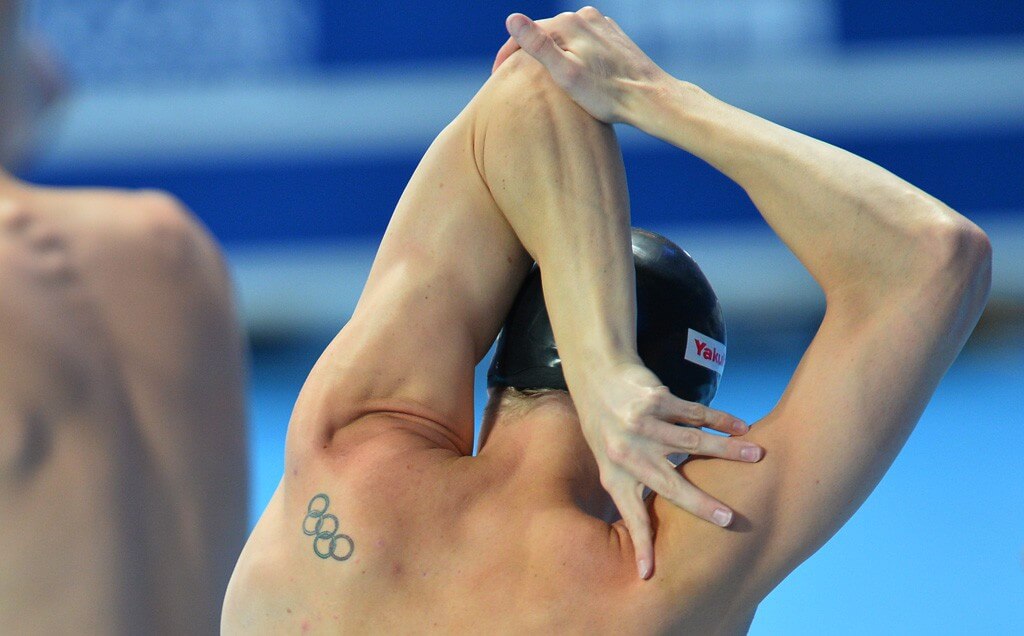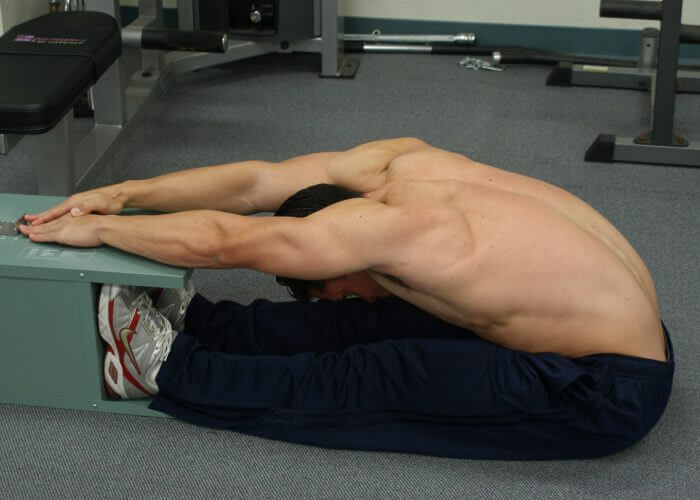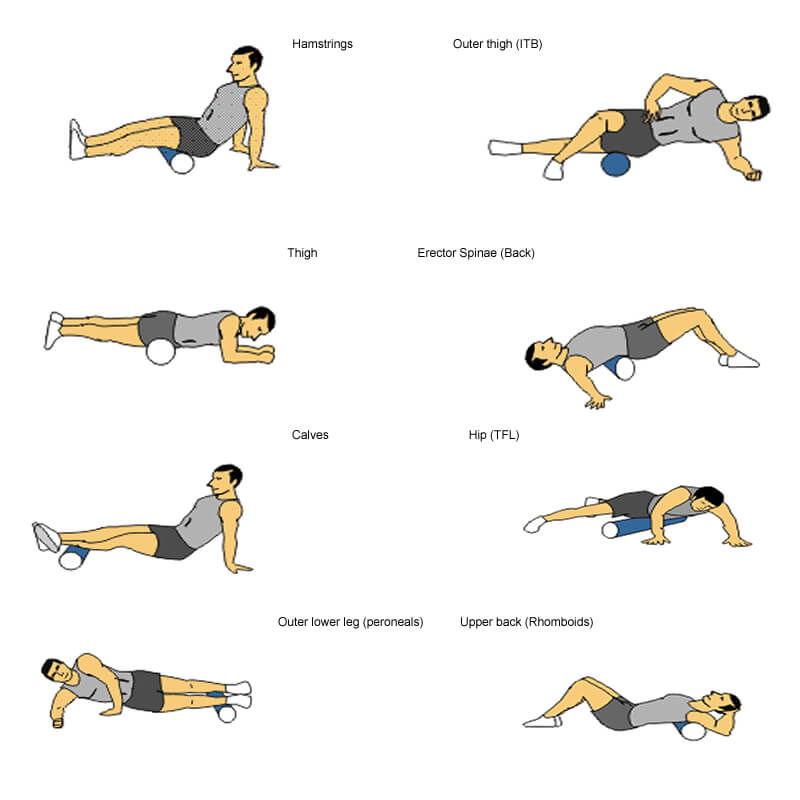Foam Rolling and SMR Don’t Change Muscle Tissue

By Dr. G. John Mullen, Swimming World Contributor
If you followed the Olympics, you probably saw many Olympians receiving soft tissue (massage) and self soft tissue (self-myofascial releases; SMR) on the pool deck. The increase in use of these techniques has been recommended by many in the sporting community. I have even suggested SMR should replace static stretching, for those seeking improvements in flexibility. Both static stretching and SMR have their place, but never is one treatment/plan the best for everyone.
I made this suggestion based on the research which suggests stretching impairs force production, whereas SMR doesn’t impair force production (Macdonald 2012). We also have research which suggests SMR improves range of motion, similar to static stretching.
Before everyone has a tizzy fit, I still do prescribe static stretching for some swimmers and patients at my physical therapy clinic. However, I do find myself providing more SMR each day! However, we still don’t know much about SMR. Many would be surprised that SMR doesn’t likely alter tissue properties. This may leave you wondering, what does SMR improve? Is it even beneficial?
Before we discuss this, you must understand the factors of flexibility.
Factors of Flexibility

Photo Courtesy: G. John Mullen
Understanding which structures in the body are pliable and can change is essential for prescribing individualized mobility programs. I wrote about the factors which improve range of motion a few years back for Swimming World stating:
Think of all the factors influencing mobility–
- Active structures: muscle with proper extensibility is generally associated with an optimal usable range of motion.
- Passive structures: ligaments can limit the range of motion due to their role as joint stabilizers. On the other hand, ligaments that are too loose can be problematic causing joint instability.
- Neural structures: sometimes there will be a lack of usable range of motion despite adequate extensibility of the muscles and ligaments. In this case, the nervous system can send sensation limiting range of motion.
- Vascular structures: veins and arteries move within the body and if they are not moving properly, they can influence range of motion.
- Other factors: elasticity of skin, adhesion between the muscle fibers and adhesions between the muscle and fascia, or even psychological factors.
Range of motion is a complex topic, which is poorly understood. At this time a few theories are used to explain the improvements in range of motion.
All the factors of mobility make it tough to isolate what factor is actually improving! Luckily, emerging evidence is finding interesting results. With all these structures which may change, here are the two areas the research suggests improve with SMR (yes, “suggests”, we still need much more research and validation).
Changes with SMR

Photo Courtesy: Booya Fitness
1. Increases Maximum Passive Pressure
Akazawa (2016) had 37 men perform self-massage at the musculotendinous junction of the hamstrings muscle (four finger widths proximal to the medial and lateral epicondyles of the femur, using their fingertips while in a sitting position: ELI5 where the thin meets the shin, the knee-pit). Participants performed self-massage for 3 minutes per day, five days per week, for 12 weeks.
After 6 and 12 weeks of intervention the maximum hip flexor angle and maximum passive pressure were significantly higher than prior to the intervention. However, there was no change in mechanical properties at the muscle (Akazawa 2016).
This suggests self-massage helps improve pressure tolerance, but doesn’t alter mechanical properties in healthy individuals not participating in regular sports.
2. Increases Arterial Mobility
Okamoto (2013) explored the acute effect of self-myofascial release with a foam roller on arterial stiffness and vascular endothelial function, as measured using pulse wave velocity in 10 healthy, but sedentary subjects (7 males and 3 females). They compared self-myofascial release with a foam roller and a control condition, then they had the participants switch groups, at least 3 days apart.
They measured brachial-ankle pulse wave velocity and plasma nitric oxide (NO) concentrations both before and 30 minutes after both conditions. The researchers found that brachial-ankle pulse wave velocity significantly decreased after the self-myofascial release with a foam roller condition, but did not change following the control condition. The researchers also found that plasma NO concentrations significantly increased after the self-myofascial release with a foam roller condition but did not change significantly after the control condition.
This may sound like ramble, but it suggests the blood flow in the vascular structures improved after foam rolling. The researchers therefore concluded that self-myofascial release with a foam roller is able to reduce arterial stiffness, improve arterial function, and improve vascular endothelial function.
Summary
Whenever one is using static stretching, dynamic stretching, SMR, or massage it is essential to have a purpose. Individualizing one’s mobility program is as important as individualizing one’s training and strength program. If someone is sporadically implementing flexibility training or not monitoring one’s flexibility program, they are asking for problems– especially since the research is still sparse on the physiological effects of SMR. Although I’m a large advocate of SMR, we must realize the limitations and areas requiring more research. This doesn’t mean we shouldn’t ever use SMR, but once again, have a purpose, monitor improvement, and adjust accordingly with the facts, not fiction!
References:
- Akazawa N, Okawa N, Kishi M, Nakatani K, Nishikawa K, Tokumura D, Matsui Y, Moriyama H. Effects of long-term self-massage at the musculotendinous junction on hamstringextensibility, stiffness, stretch tolerance, and structural indices: A randomized controlledtrial. Phys Ther Sport. 2016 Jan 28;21:38-45. doi: 10.1016/j.ptsp.2016.01.003. [Epub ahead of print]
- Okamoto T, Masuhara M, Ikuta K. Acute Effects of Self-MyofascialRelease Using a Foam Roller on Arterial Function.J Strength Cond Res. 2013 Apr 9. [Epub ahead of print]



